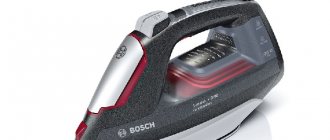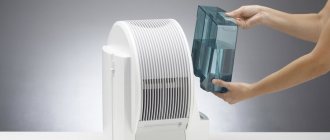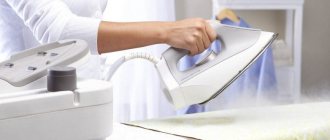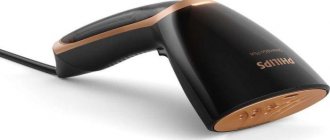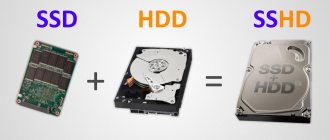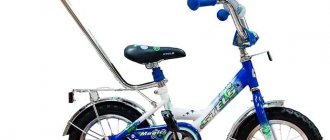Design and principle of operation
Despite the external similarity of the working elements, the operating principle of these devices is radically different.
The main components of the iron:
- Metal platform with a heating element hidden in it.
- A power cord that is attached to a terminal block.
- Water chamber hidden inside the body.
- Thermostat, which is responsible for regulating the temperature.
- Steam generation system, which includes a steam boost button and a supply intensity regulator.
When you turn on the device, the soleplate heats up to the desired temperature. Water poured into the chamber, when you press the “steam boost” button, enters the tank in portions, where it is instantly heated, coming into contact with a hidden heating element, and comes out in the form of steam through the holes in the sole.
Key components of steam stations:
- Iron.
- Steam line.
- Housing with boiler and control panel.
- Power cable.
Water is poured into the tank, when the device is turned on, it heats up to a high temperature (about 130 ° C), turns into dry steam and is supplied through a hose to the iron. Depending on the model, the control panel may contain feed regulators, a pressure gauge, and work readiness indicators. From the moment the device is turned on, it takes 2–10 minutes to fully warm up.
The steamer is similar in design to a steam generator. Water is poured into the boiler in the same way and supplied through a hose. The main differences between these devices:
- Steam has a lower temperature (about 90o C).
- Do not iron with the working attachment.
- Ready for use within 30 seconds after switching on.
- Steam comes out naturally or under slight pressure.
The main purpose of the steamer is to remove odors and wrinkles from vertically hanging items.
Can a steamer replace an iron?
The preferred use of a particular device depends on what needs to be done daily - ironing or steaming.
Therefore, when choosing a device, you need to consider the following factors:
- When all family members need to wear ironed clothes every day, then a steamer or steam generator would be most suitable for such cases. The steamer can handle large volumes of clothing faster. At home it successfully replaces the iron.
- If we are talking about ironing 2-3 items, then you can get by with a regular iron with a steam function. With small volumes, the quality of ironing will always be at a high level.
- If you have the finances, you can buy two devices and use them, depending on the amount of clothes that need to be ironed.
Model functionality
Most of the functions of the iron and the device with a steam generator are identical. Only a few parameters may differ.
Vertical steaming
This function is included in almost all models costing over 500 rubles. However, it is implemented differently. To steam vertically hanging items with a regular iron, you need to hold it suspended (the weight of the model with water can be 1.5-2 kg) and periodically press the steam button. In this case, after each release of steam, the device needs to gain temperature, therefore, there will be constant pauses in operation.
In models with a steam generator, steam is supplied continuously, in a much larger volume; moreover, the weight of the iron is much less (from 0.8 kg), therefore, it is easier to hold it in weight.
splashing
This feature is found in almost all classic models. This does not always happen in devices with a steam generator. For those who are used to refreshing laundry the “old-fashioned” way, the lack of a nozzle can cause some inconvenience.
Descaling
If in ordinary irons, during a burst of steam, particles of lime are thrown onto the fabric, then in steam generators this situation is practically excluded - the water is heated at the base, and comes out in the form of steam.
Therefore, in classic models it is necessary to clean the internal tank; in steam stations, maintenance is required for the boiler. The cleaning method depends not so much on the type of device, but on the model and specific company.
Other functions, such as auto shutdown, energy saving mode, sound or light indication of readiness for use, can be found in devices of different types.
The steamer does not have a variety of programs, only the steam supply is regulated, but it can have a rich set, which includes clips for trousers, a brush attachment for clothes, hangers on which to hang a shirt, etc.
Steamer
How the steamer works
The design of the steamer consists of the following parts:
- Steam generator.
- Container with heating element.
- Special nozzles.
Steaming occurs without contact. The steam simultaneously smoothes and disinfects fabrics.
Advantages and disadvantages
More gentle effect on the fabric compared to the soleplate of the iron. Does not damage decor - beads, rhinestones, etc.
The large volume of water in the boiler ensures long-term operation.
In addition to wrinkles, old dried stains and unpleasant odors are eliminated.
Vertical processing does not require an ironing board.
The device must not be turned over to avoid burns.
Natural fabrics require increased power.
High cost of modern devices.
Weight, mobility and size
The weight of the iron in steam stations is significantly less than classic models, since they do not have a water tank. However, the total mass of a steam station is on average 5–7 kg.
In addition, the boiler takes up a lot of storage space. When ironing, the steam station requires a special area for installation - a stand on a regular wooden board is not suitable for its placement.
To make it easier to carry, many manufacturers equip the device with a lock that securely secures the iron to the base. This way you can carry the entire structure by the handle.
The steamer is similar in size to a steam generator. The device is often equipped with a vertical stand on which clothes or a hose with a nozzle are hung.
Speed and quality of ironing
In many ways, the speed of ironing depends on the ease of sliding of the sole over the fabric. The following materials are used in the manufacture of the platform:
- Aluminum.
- Teflon.
- Stainless steel.
- Ceramics.
- Metal ceramics.
Aluminum material is soft, it scratches easily and does not have non-stick properties. Fabric particles will not stick to Teflon coating, however, such a surface can be easily scratched by metal accessories on clothing. Stainless steel conducts heat well and is durable, but does not have non-stick properties.
These materials are rarely found in their pure form, only in budget models. As a rule, manufacturers try to modify them or combine them with other materials to impart strength and non-stick properties.
Ceramics and cermets are much more common. They have good non-stick properties and glide perfectly over the fabric. Such coatings are found in steam stations and in classic irons, so the ironing speed of these devices is approximately the same and depends more on the specific model and manufacturer.
In addition, the speed of ironing depends on the intensity of steaming - the faster the device straightens the folds, the sooner the item will acquire a neat appearance. In this case, the model with a steam generator, which is capable of smoothing fabric folded in 3-4 layers in one pass, will definitely win. An iron or steamer for home clothes will not cope with this task.
You can iron shirts using a steam generator or steamer directly on the hanger. In this case, the steamer does not come into direct contact with the fabric; it cannot straighten out folds due to the high temperature of the surface of the nozzle. The feeding intensity is also low, so in order to smooth out wrinkles and wrinkles you have to go through the same area several times.
Which manufacturers should you look at?
When you come to a store or look through lines of products on the Internet, pay attention to those who have been producing equipment for a long time, read customer reviews. Unknown companies will become a dark horse for us, and trusted manufacturers provide a guarantee of quality.
- Scarlett sells the most affordable devices. They are easy to use and come complete with attachments.
- Polaris offers options with different steam settings. Personally, I like it when there are programs indicating the type of fabric, it’s easier to navigate and not waste time studying the instructions. If you choose in a store, pay attention to the rigidity of the spray hose. It is better to choose those that do not bend.
- Tefal has always had a high price, but its quality is excellent! Judging by the reviews, the Instant Control model is capable of changing the steam pressure, helping to select the mode for the fabric and dirt.
- Philips is also an expensive manufacturer. My attention was drawn to a device with the Essence prefix; it has a very interesting feature: a capsule for scenting laundry, you can pour your favorite scent into it and enjoy.
What I never recommend is Chinese technology. No Tifal or Phillips can replace the real brand!
Difficulty to use
It is difficult to steam curtains or vertically hanging clothes with a regular iron, since the entire weight of the device rests on your outstretched arm.
It is difficult to tidy up heavily wrinkled clothes with a steamer, since this device does not have an ironing function. But the device can be placed on the floor and rolled to the desired location, even if it is in another room. In the case of a steam generator, performing such an operation is quite problematic. You will have to assemble the device and drag it manually, and then still look for a place to install it.
How to make a choice
When thinking about what to choose for your home: an iron, a steamer or an iron with a steam generator, you need to determine in advance what tasks the device should perform.
If the owner plans to constantly iron on a board and process curtains a couple of times a year, it is worth choosing a classic model with a good steam boost.
If the buyer most often has to tidy up outerwear, suits and other delicate items, but does not want to overpay for sophisticated equipment, a steamer would be the best option.
If you have to iron often and a lot, and the buyer is not tasked with saving money, the optimal solution would be a steam generator that can replace both a regular iron and a steamer.
When choosing a steam generator, iron or steamer, you should carefully study the technical characteristics of the device and the rating of the best models in order to choose the best option for your needs.
What are they and why are they needed?
Before you find out which steamer to choose for your home, you need to understand what it is and what its main purpose is. If you iron with a regular iron, you have to take out the ironing board, set it up and iron things for a long time. It is difficult to iron delicate clothes or oversized curtains using an iron.
The steamer can easily handle curtains. Just hang them on the curtain rod and turn on the steamer. Irons often leave unsightly marks on fabric. There are times when a burnt hole appears on the material.
You can avoid many problems with the help of a steamer. The device uses hot steam to treat any fabric, and does it completely safely. To start steaming, you need to pour some water into the tank. There will no longer be a need to select the correct iron setting. Steamers usually come with attachments. They allow you to further clean the item, for example, if there are cats or dogs in the house.
A steamer is needed to:
- Remove creases from fabric quickly and efficiently.
- Disinfect children's clothes after washing.
- Remove unpleasant odors.
- Smooth delicate and thin fabrics. Using the device, it is convenient to steam materials of different densities.
- Steam clothes decorated with decorative elements. Modern models also steam lined outerwear.
- Kill ticks living in blankets, pillows, mattresses.
- Remove dirt and animal hair from furniture, clothing.
Using a steamer, you can destroy parasites invisible to the eye. Of course, the device cannot handle all types of fabrics, but most often it is better than an iron.
